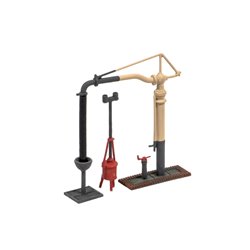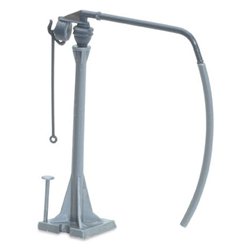This is really a matter of personal choice and what you want to get out of your model railway. There is a lot to be...
No products
Product successfully added to your shopping cart
There are 0 items in your cart. There is 1 item in your cart.
Search Tips
Christmas and New Year
We are dispatching orders every weekday apart from Christmas Day, Boxing Day and New Year's Day.
If you order is time critical, select next day delivery at checkout.
The shop in Sandown is closed from 25th December, reopening on 30th December.
What were water cranes used for?
In the era of steam locomotives, water cranes, often referred to as water columns or water towers, played a crucial role in the daily operations of the railway network across the United Kingdom. Their primary function was to supply steam engines with the vast quantities of water necessary for their operation. This was vital because steam locomotives relied on the production of steam, generated by heating water, to power their engines and pull trains over long distances.
Water cranes were typically installed at railway stations, depots, and strategic locations along the rail network. These installations were essential to ensure that locomotives could refill their tenders with water without causing significant delays to the railway service. The tenders, which were wagons attached to the locomotive, had a significant capacity for water storage, often holding thousands of gallons. This large capacity was essential given that steam engines could consume water at an alarming rate, particularly on long journeys or when hauling heavy loads.
The placement of water cranes was often carefully planned to coincide with scheduled stops or locations where trains would naturally pause, such as major junctions or termini. This strategic positioning allowed for quick refills and helped maintain the efficiency and punctuality of the railway services. Railways were the backbone of transportation during the steam era, and any delay in water supply could cause significant disruptions. As such, having water readily available at key points ensured a seamless flow of services, meeting both passenger and freight needs.
Engineering and Operation
The design of water cranes was quite simple yet effective. They consisted of a vertical column with a swivelling arm, which could be manoeuvred over the tender to deliver water. At the end of the arm was a nozzle, which could be lowered to fit into the tender’s water inlet. Water was either gravity-fed from a nearby water tower or pumped directly from an underground reservoir or nearby water source. The operation of these cranes required some manual intervention, with railway staff responsible for positioning the crane and managing the flow of water.
The speed at which water could be delivered was an important consideration, as it directly impacted the efficiency of refilling processes. A well-functioning water crane could fill a tender in a matter of minutes, allowing the locomotive to continue its journey with minimal delay. This rapid refilling capability was particularly crucial on busy main lines where frequent stops could otherwise lead to congestion and scheduling issues.
Importance in Different Geographical Areas
Geographical considerations also influenced the distribution and necessity of water cranes. In regions with long stretches of track without natural water sources, such as some rural areas or routes traversing hills, water cranes were indispensable. Rail companies invested significantly in infrastructure to ensure that these areas were well-equipped with water cranes, as running out of water in remote locations could lead to severe operational challenges, including stranding a train mid-journey.
In contrast, routes running through urban or industrial areas might have had more readily available water supplies, but the frequency and weight of traffic meant that water cranes were still a necessity. Even in these areas, the strategic placement of water cranes ensured that high-demand routes remained functional and efficient, supporting the intense railway traffic typical of industrial regions during the peak of steam railway operations.
Evolution and Decline
With the advent of diesel and electric locomotives in the mid-20th century, the need for water cranes diminished significantly. Diesel and electric trains did not rely on steam and therefore did not require regular water supplies. As a result, many water cranes fell into disuse and were eventually removed or repurposed. However, during the steam era, they were indispensable to the railway network's success, ensuring that trains could operate smoothly across vast distances.
Despite their decline, water cranes remain a symbol of the steam railway era and are still found in some heritage railways across the UK, where steam locomotives are preserved and operated for historical and recreational purposes. These heritage lines maintain water cranes as a nod to their historical significance and to provide authentic experiences for enthusiasts and tourists who wish to see steam locomotives in action.
In summary, water cranes were an essential component of the railway infrastructure during the steam locomotive era, enabling efficient operations by ensuring steam engines had a consistent and reliable water supply. Their strategic placement and engineering simplicity played a vital role in maintaining the punctuality and efficiency of rail services across the UK, illustrating their importance in the history of British railways. Today, they serve as a reminder of the ingenious solutions that characterised the age of steam.
Click here to receive the tips weekly in your mailbox. You can unsubscribe at any time.










